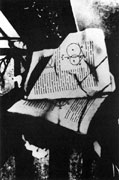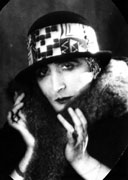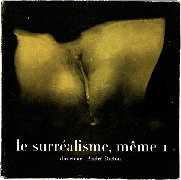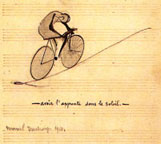click to enlarge

Illustration 1
Duchamp’s Studio,
33 West 67 Street,
New York, 1917-18
© 2000 Succession Marcel
Duchamp ARS, N.Y./ADAGP, Paris.
click to enlarge


Illustration 2
Marcel Duchamp,
Unhappy Readymade, 1919
© 2000 Succession Marcel Duchamp ARS, N.Y./ADAGP, Paris.
The Duchamp Bicycle Wheel(1913), and Stool was only referred to by Duchamp but was never seen because Duchamp claimed that it was “lost” and undocumented by any photographs.
The 1941 print of his Bicycle Wheel in the Boite en Valise (the first time that we see a visual representation relevant to, but not actually depicting, his 1913 original) was chosen by Duchamp from a series of at least five studio photographs (circa 1916-17) taken of the2nd version, made in his New York studio. The photograph that Duchamp selected to use for creating his 1941 Boite pochoir print appears to be retouched. (We are in the process of subjecting this image to forensic analysis for further determination of the specific alterations.) Based upon the depicted bicycle wheel and stool shapes, I argue that the movement of the wheel would hardly be relaxing (as in watching a fireplace) but would, in fact, continually wobble out a warning of an eventual crash and fall of the stool. (See my article “Why is the Bicycle Wheel Shaking?”)
click to enlarge

Illustration 3
Marcel Duchamp,
Rrose Sélavy by Man
Ray, 1921
© 2000 Succession Marcel
Duchamp ARS, N.Y./ADAGP, Paris.

Illustration 4
Marcel Duchamp,Cover for
“Le Surréalisme, même,” Winter
1956, 1956
© 2000 Succession Marcel
Duchamp ARS, N.Y./ADAGP, Paris.
In addition to the distorted shape of the bicycle wheel and stool in the source photograph for Duchamp’s 1941 Boite en Valise print (see Illustration 1), the stool rungs and legs are extremely blurred in ways that contrast with the other, more sharply-focused, surface. One is led to ask — are the legs and rungs askew due to photographic or physical alterations? Duchamp’s use of photographic alterations would not be surprising. Scholars readily acknowledge that Duchamp, throughout his career, retouched photographs. Examples include Unhappy Readymade (1919) (where Duchamp adds the appearance of a printed geometric axiom to a photograph of book pages whose typeface had been washed away by rain), the famed Rrose Selavy portraits (1921) by Man Ray (where Duchamp enhances Rrose’s hands), and the cover of Surrealism, Même (1956) (where Duchamp retouches a photograph of his concave fig leaf sculpture to enhance the illusion of convexity already, in part, created by special effects lighting). (See illustrations 2, 3, 4)
click to enlarge

Illustration 5
Marcel Duchamp,
Photo of Duchamp riding
on the Bicycle, 1902
© 2000 Succession Marcel
Duchamp ARS, N.Y./ADAGP, Paris.

Illustration 6
Marcel Duchamp,
To Have the Apprentice
in the Sun, from the
Box of 1914, 1914
© 2000 Succession Marcel
Duchamp ARS, N.Y./ADAGP, Paris.
Moreover, Duchamp knew that the common bicycle design for front wheels incorporated a curved fork and yet in his 1916-17 2nd version he uses a straight fork! Note here a boyhood photo of Duchamp riding his bicycle in 1902 and his drawing from the 1914 Box — both depicting the curved forks that were conventionally used even when Duchamp was a child (see Illustrations 5 & 6). One must not forget that enthusiasm for new technologies, gadgets and inventions was at its zenith in the early 20th century. Since straight forks were only briefly in used in modern “safety bicycle” design (and therefore quickly became obsolete by the late 1880’s), Duchamp appears to be making a conscious point when he selects, in 1916-17, an obsolete design for a “readymade” during an era that embraced hi-tech mass production. Even in 1916-17, most junked bicycle fork parts readily found (using modern spoked wheel and metal rim) would be curved in shape and any straight fork design infrequently found as visual oddity appearing retrograde and old-fashioned (and most often seen with a primitive wheel and wood spokes).



